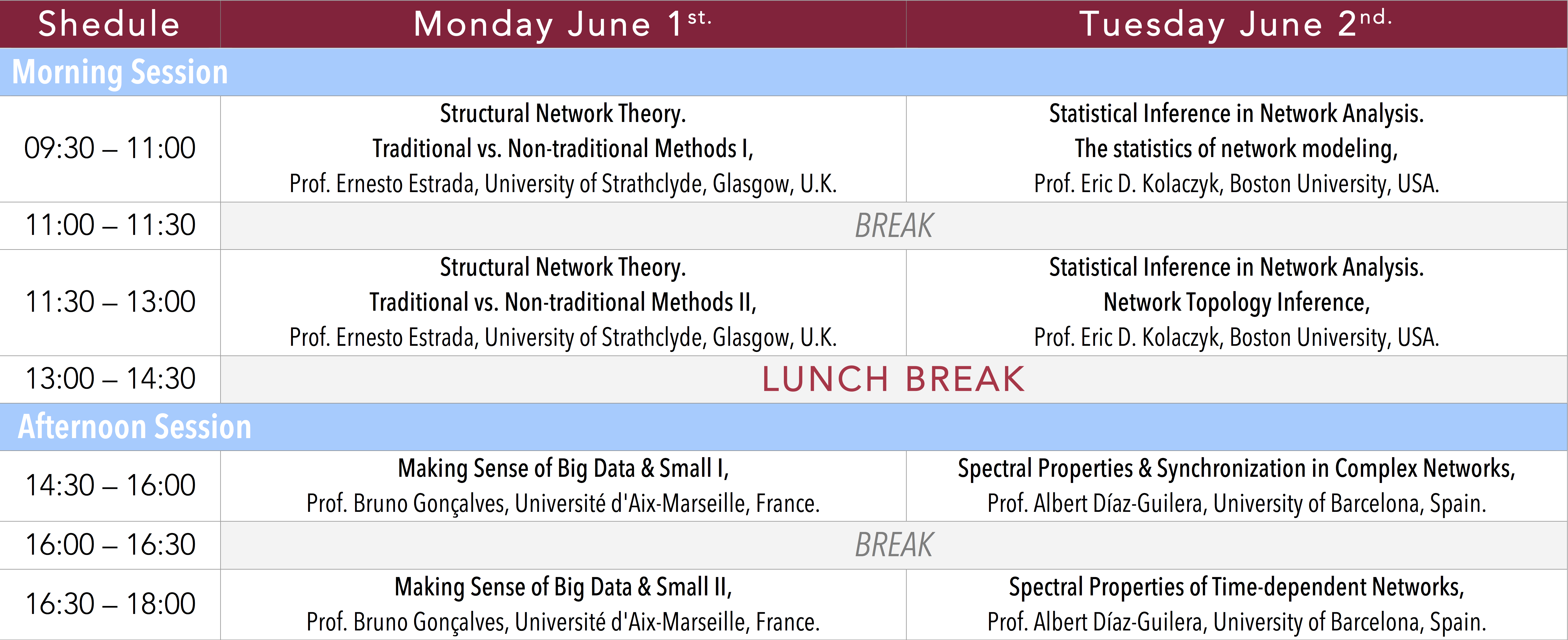Please, find below the Scientific Program of Netsci 2015. You can download two different versions: a Booklet version for printing and an A4 single-page format.
- Detailed Scientific Program, Booklet Version (designed by I. Meirelles): Download pdf here.
- Scientific Program, A4 single-page version: Download pdf here.

1- Structural Network Theory. Traditional vs. Non-traditional Methods, Prof. Ernesto Estrada.
I will introduce or refresh some of the most basic concepts of structural network theory, such as degree distributions, assortativity, communication by shortest paths, etc. Then, I will illustrate some of the difficulties that you may find in the practical application of these concepts to real-world situations. In contrast, I will show how novel algebraic and spectral techniques can sort out these difficulties. The main questions that these approaches will respond include: How to compare degree heterogeneities of diverse networks in the presence of scarce data? What is the structural meaning of assortativity? How can you navigate a network without knowing the shortest paths routes?, etc.
2- Making sense of Data Big and Small, Dr. Bruno Gonçalves.
The increasing availability of huge amounts of data on every aspect of societal and individual behavior has created unprecedented opportunities but it also created new challenges. On one hand, it is now much easier to acquire detailed datasets no practically anything while on the other it is much harder to make sure that our observations and conclusions are well justified and robust. In this short 3h tutorial we will briefly introduce some of the fundamental principles and algorithms of Machine Learning in an intuitive and practical way. Mathematical requirements will be kept to a minimum and short snippets of Python code will be presented to illustrate the application of each algorithm.
3- Statistical Inference in Network Analysis, Prof. Eric D. Kolaczyk
In the analysis of network data, as with any other data type, there are many contexts in which problems of statistical inference arise. However, the inherently relational nature of network-indexed data poses a number of additional challenges in performing statistical analysis, which are further compounded in many cases by the sheer magnitude of the data at hand. In these talks, we will examine two major paradigms in which statistical inference arises: (1) the statistics of network modeling, and (2) network topology inference. The focus will be on drawing parallels with more familiar (e.g., `Statistics 101') formulations of these types of inference problems, allowing us to compare and contrast, and hence highlight the unique aspects of these problems when networks enter the picture.
4- Prof. Albert Díaz-Guilera
I) Spectral properties and synchronization in complex networks
I will introduce the Kuramoto model of synchronization of phase oscillators. Starting from very simple settings I will show which are the conditions for the system to synchronize. If oscillators are identical, after a transient, the system approaches the synchronized state in such a way that the equations of motion can be linearized. This can be solved in terms of normal modes and establish the relation between topology (by means of eigenvalues of the static Laplacian matrix of the network) and dynamics (in terms of the time needed to synchronize). Furthermore, I will show that intermediate time scales are related to subsets of eigenvalues and communities.
II) Spectral properties of time-dependent networks
I will show how to generalize spectral properties and dynamical approach to a synchronized state in the case of moving oscillators. When oscillators move and they can interact with nearby oscillators they form a time dependent contact network. In terms of the time scales for motion and synchronization we describe the different regimes of the system.


